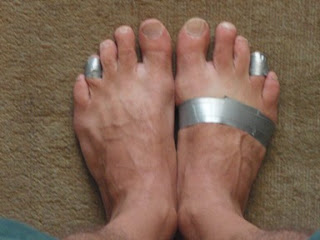By and large, another disappointing week. There were a few “ups,” but I am finding my motivation and spirit lagging. My morale was pretty low. Consequently, I’ve been exploring some solutions to get me past this morass, most notably, meditation. I’ve returned to Joseph Arpaia and Lobsang Ragpay’s Real Meditation in Minutes a Day to help me focus on recommitting to the most important aspects of my life.
SundayNo work.
No excuses here. Just a bad day to rollout. I'm finding my weekend sleep-ins to be somewhat counter-intuitive to what I'm trying to do here. I'm going to try to start up the next week with getting up at the same time, regardless of whether I am working-from-home, going to Denver, or on a weekend date.
Monday
- Men's Fitness Yearlong Workout Phase 2, Workout 1 (80 lb barbell; 21 lb. dumbells)
- 14 pushups, rest for 14 seconds; 13 pushups, rest for 13 seconds; 12 pushups, rest for 12 seconds; etc., through to 1 pushup, rest for 1 second (105 pushups).2 mile "Boys' Training Run"
- 5.3 mile run (time not recorded)
- 10 minutes yoga/stretching
A very good day. This is the kind of banner day that I'd like more of my days to turn into. But I think sometimes I'm trying to force to much into one day to make-up for days that I "take off." I don't think that's helpful. I should do better about doing some each day rather than a lot two or three days a week.
Tuesday
- 20 minutes yoga/stretching, incorporating aspects from the Men's Fitness Prehab Workout (no weights, body resistance only)
Meh.
WednesdayNo work.
Awful. Absolutely no excuse for taking Wednesday off other than fatigue. Fatigue is not being "relentless."
Thursday
- Men's Fitness Yearlong Workout Phase 2, Workout 2 (80 lb barbell; 21 lb. dumbells).
- 14 pushups, rest for 14 seconds; 13 pushups, rest for 13 seconds; 12 pushups, rest for 12 seconds; etc., through to 1 pushup, rest for 1 second (105 pushups).
- Boxing routine: 1 minute heavy bag workout & 100 skipropes x 10 reps.
- 2 mile fun run.
Friday
6.7 mile run in 57 minutes (8:30 miles)
Now we're talking. I've been gradually upping my distance over the past couple of weeks. I can't remember the last time I nearly hit 7 miles...probably in preparation for the BolderBoulder. Now that I'm back to being in excess of 10K, I would like to start adding a half mile to my runs and doing two longer runs (for me, anyway) twice weekly. Must hit 13.1 by March.
Somewhat psyched that my new running shoes came in the mail on this day, too, though too late to run in.
Somewhat psyched that my new running shoes came in the mail on this day, too, though too late to run in.
Saturday
No work.
Ugh. A slave to the old habits. Had too much of a good time on Friday night and paid for it with a bad night's sleep, a stiff neck, and a surly attitude all day today. My wife was kind enough to give a little time to try to balance out and I spent it revisiting Real Meditation (see above). Recommitting to my mental health as a most important aspect of my health starting tomorrow in earnest. I tried a "warmup" session today with terrible results -- I fell asleep. Got to be better about it starting tomorrow. Planning on extended sessions in the morning (hence the need to get up at the same time each day) and five or six rapid recharge sessions throughout the day.
I'll have more details on my meditation progress starting tomorrow.














